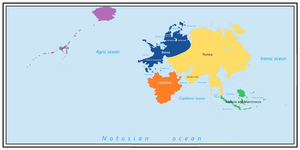Aurorum (region): Difference between revisions
No edit summary |
|||
| Line 27: | Line 27: | ||
}} | }} | ||
'''Aurorum''', commonly known as ''' | '''Aurorum''', commonly known as '''Earth''' or '''the world''', is a {{wp|Terrestrial planet|terrestrial planet}} orbiting the Sun. It is the fifth-largest and fifth-most-massive object in the Solar System, as well as the only currently known celestial body in the Solar System and the known {{wp|universe}} to harbor and sustain {{wp|life}}. Additionally, it is the largest and densest of the Solar System's rocky planets. Aurorum constitutes a {{wp|binary planet|binary planetary system}} together with its only {{wp|natural satellite}}, the Moon or ''Luna'', that makes up 40% of the binary system's total mass. | ||
Aurorum is unique in that its surface consists partly of {{wp|liquid water}}, both as salt-water and freshwater, making up the {{wp|hydrosphere}}, and an active planetary {{wp|geology}} with {{wp|tectonic plates}}, active geothermal activity and a {{wp|geomagnetic field}}. This allows the planet to have developed a rich {{wp|atmosphere}} consisting mainly of {{wp|nitrogen}}, {{wp|oxygen}} and other gasses, which in turn results in the {{wp|water cycle}}, {{wp|greenhouse effect}} and {{wp|weather}} existing as a dynamic system on Aurorum. Various factors such as the aforementioned and particularly Aurorum's distance from the Sun allowed for the planet to proliferate {{wp|anaerobic organism|anaerobic}} and later {{wp|aerobic organism|aerobic life}} some 4.1 billion years ago. Since, life has evolved and thrived over long periods of Aurorum's history, spawning a plethora of {{wp|biodiversity}} and occassionally punctuated by {{wp|mass extinction|mass extinction events}}. Today, the modern {{wp|human}} (''homo sapiens'') inhabits Aurorum and has increasingly altered its {{wp|climate change|climate and atmosphere}}, {{wp|biodiversity loss|biosphere}} and {{wp|land use|surface}} in what is dubbed the "{{wp|anthropocene}}". | |||
==Etymology== | ==Etymology== | ||
Revision as of 17:56, 5 August 2021
This article is incomplete because it is pending further input from participants, or it is a work-in-progress by one author. Please comment on this article's talk page to share your input, comments and questions. Note: To contribute to this article, you may need to seek help from the author(s) of this page. |
| Atmosphere | |
|---|---|
Aurorum, commonly known as Earth or the world, is a terrestrial planet orbiting the Sun. It is the fifth-largest and fifth-most-massive object in the Solar System, as well as the only currently known celestial body in the Solar System and the known universe to harbor and sustain life. Additionally, it is the largest and densest of the Solar System's rocky planets. Aurorum constitutes a binary planetary system together with its only natural satellite, the Moon or Luna, that makes up 40% of the binary system's total mass.
Aurorum is unique in that its surface consists partly of liquid water, both as salt-water and freshwater, making up the hydrosphere, and an active planetary geology with tectonic plates, active geothermal activity and a geomagnetic field. This allows the planet to have developed a rich atmosphere consisting mainly of nitrogen, oxygen and other gasses, which in turn results in the water cycle, greenhouse effect and weather existing as a dynamic system on Aurorum. Various factors such as the aforementioned and particularly Aurorum's distance from the Sun allowed for the planet to proliferate anaerobic and later aerobic life some 4.1 billion years ago. Since, life has evolved and thrived over long periods of Aurorum's history, spawning a plethora of biodiversity and occassionally punctuated by mass extinction events. Today, the modern human (homo sapiens) inhabits Aurorum and has increasingly altered its climate and atmosphere, biosphere and surface in what is dubbed the "anthropocene".
Etymology
Physical characteristics
Oceans and continents
Most of Aurorum's surface is subdivided into oceans, which constitute the majority of its hydrosphere, and continents, which are the planet's largest landmasses. By convention, the four oceans consist of the Iremic, Agric, Notosian, and Caphtoric, while the five continents consist of Pamira, Berea, Caphtora, Melasia and Mavronesia, and Alvinia.
Orbit and rotation
Human geography
| Name | Capital | Population | Continent | Head of state | Head of government | Government type |
|---|---|---|---|---|---|---|
| 4,271,073 (2016) | Alvinia | Actuq Tsultloya | Miguel Saquha | Presidential republic | ||
| 44,794,500 (2020) | Berea | Edwin IV | Clifford Goodwin (protecting) Ale Dykstra |
Absolute monarchy | ||
| 48,972,336 (2018) | Berea | Dorothea I | Thomas Falkner | Federal parliamentary constitutional monarchy | ||
| 18,042,854 (2018) | Berea | Stanisława I | Karol Kowalczyk | Unitary parliamentary constitutional monarchy |
